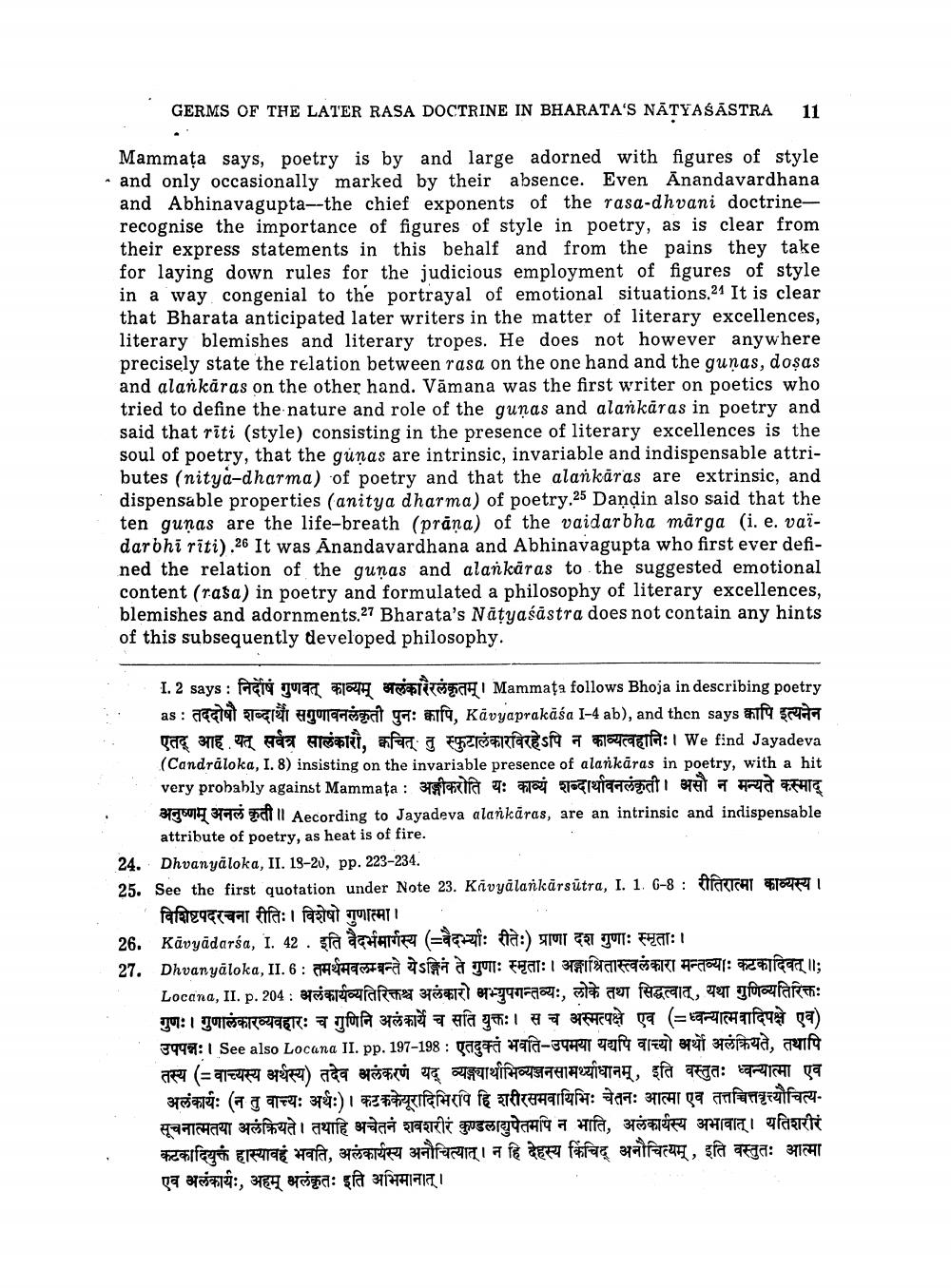________________
GERMS OF THE LATER RASA DOCTRINE IN BHARATA'S NATYASASTRA 11
Mammața says, poetry is by and large adorned with figures of style - and only occasionally marked by their absence. Even Anandavardhana and Abhinavagupta--the chief exponents of the rasa-dhvani doctrinerecognise the importance of figures of style in poetry, as is clear from their express statements in this behalf and from the pains they take for laying down rules for the judicious employment of figures of style in a way congenial to the portrayal of emotional situations,21 It is clear that Bharata anticipated later writers in the matter of literary excellences, literary blemishes and literary tropes. He does not however anywhere precisely state the relation between rasa on the one hand and the gunas, dosas and alańkāras on the other hand. Vāmana was the first writer on poetics who tried to define the nature and role of the gunas and alankāras in poetry and said that riti (style) consisting in the presence of literary excellences is the soul of poetry, that the gunas are intrinsic, invariable and indispensable attributes (nitya-dharma) of poetry and that the alankāras are extrinsic, and dispensable properties (anitya dharma) of poetry.25 Dandin also said that the ten gunas are the life-breath (prāna) of the vaidar bha mārga (i. e. vaidarbhi riti).26 It was Anandavardhana and Abhinavagupta who first ever defined the relation of the gunas and alan käras to the suggested emotional content (rasa) in poetry and formulated a philosophy of literary excellences, blemishes and adornments.27 Bharata's Näțyaśāstra does not contain any hints of this subsequently developed philosophy.
I. 2 says : निर्दोषं गुणवत् काव्यम् अलंकारैरलंकृतम्। Mammata follows Bhoja in describing poetry ___ as : तददोषौ शब्दार्थी सगुणावनलंकृती पुनः क्वापि, Kavyaprakāsa I-4 ab), and then says कापि इत्यनेन
एतद् आह . यत् सर्वत्र सालंकारी, क्वचित् तु स्फुटालंकारविरहेऽपि न काव्यत्वहानिः । We find Jayadeva (Candrāloka, I. 8) insisting on the invariable presence of alankāras in poetry, with a hit very probably against Mammata : अङ्गीकरोति यः काव्यं शब्दार्थावनलंकृती। असौ न मन्यते कस्माद् अनुष्णम् अनलं कृती॥ Aecording to Jayadeva alaileāras, are an intrinsic and indispensable
attribute of poetry, as heat is of fire. 24. Dhvanyaloka, II. 18-20, pp. 223-234. 25. See the first quotation under Note 23. Kavyālaileārsutra, I. 1.6-8: रीतिरात्मा काव्यस्य ।
विशिष्टपदरचना रीतिः। विशेषो गुणात्मा। 26. Kavyādarsa, I. 42 . इति वैदर्भमार्गस्य (=वेदाः रीतेः) प्राणा दश गुणाः स्मृताः। 27. Dhvanyāloka, II. 6 : तमर्थमवलम्बन्ते येऽङ्गिन ते गुणाः स्मृताः। अङ्गाश्रितास्त्वलंकारा मन्तव्याः कटकादिवत् ॥;
Locana, II. p. 204 : अलंकार्यव्यतिरिक्तश्च अलंकारो अभ्युपगन्तव्यः, लोके तथा सिद्धत्वात् , यथा गुणिव्यतिरिक्तः गुणः । गुणालंकारव्यवहारः च गुणिनि अलंकार्ये च सति युक्तः। स च अस्मत्पक्षे एव (= ध्वन्यात्मवादिपक्षे एव) उपपन्नः। See also Locana II. pp. 197-198 : एतदुक्तं भवति-उपमया यद्यपि वाच्यो अर्थो अलंक्रियते, तथापि तस्य (= वाच्यस्य अर्थस्य) तदेव अलंकरणं यद् व्यङ्गयार्थाभिव्यञ्जनसामाधानम्, इति वस्तुतः ध्वन्यात्मा एव
अलंकार्यः (न तु वाच्यः अर्थः)। कटककेयूरादिभिरपि हि शरीरसमवायिभिः चेतनः आत्मा एव तत्तच्चित्तवृत्त्यौचित्यसूचनात्मतया अलंक्रियते। तथाहि अचेतनं शवशरीरं कुण्डलायुपेतमपि न भाति, अलंकार्यस्य अभावात्। यतिशरीरं कटकादियुक्तं हास्यावहं भवति, अलंकार्यस्य अनौचित्यात् । न हि देहस्य किंचिद् अनौचित्यम् , इति वस्तुतः आत्मा एव अलंकार्यः, अहम् अलंकृतः इति अभिमानात् ।




